Genesis of the Mengshan Granitoid Complex in an Early Mesozoic Intracontinental Subduction Tectonic Setting in South China: Evidence from Zircon U-Pb-Hf Isotopes and Geochemical Composition
Abstract
:1. Introduction
2. Geological Setting
3. Sample Collection and Analytical Methods
3.1. Sample Characteristics
3.2. Analytical Methods
4. Results
4.1. Geochemistry
4.2. Geochronology
4.3. Hf Isotopic Compositions
5. Discussion
5.1. Chronological Significance
5.2. Petrogenesis and Magmatic Source
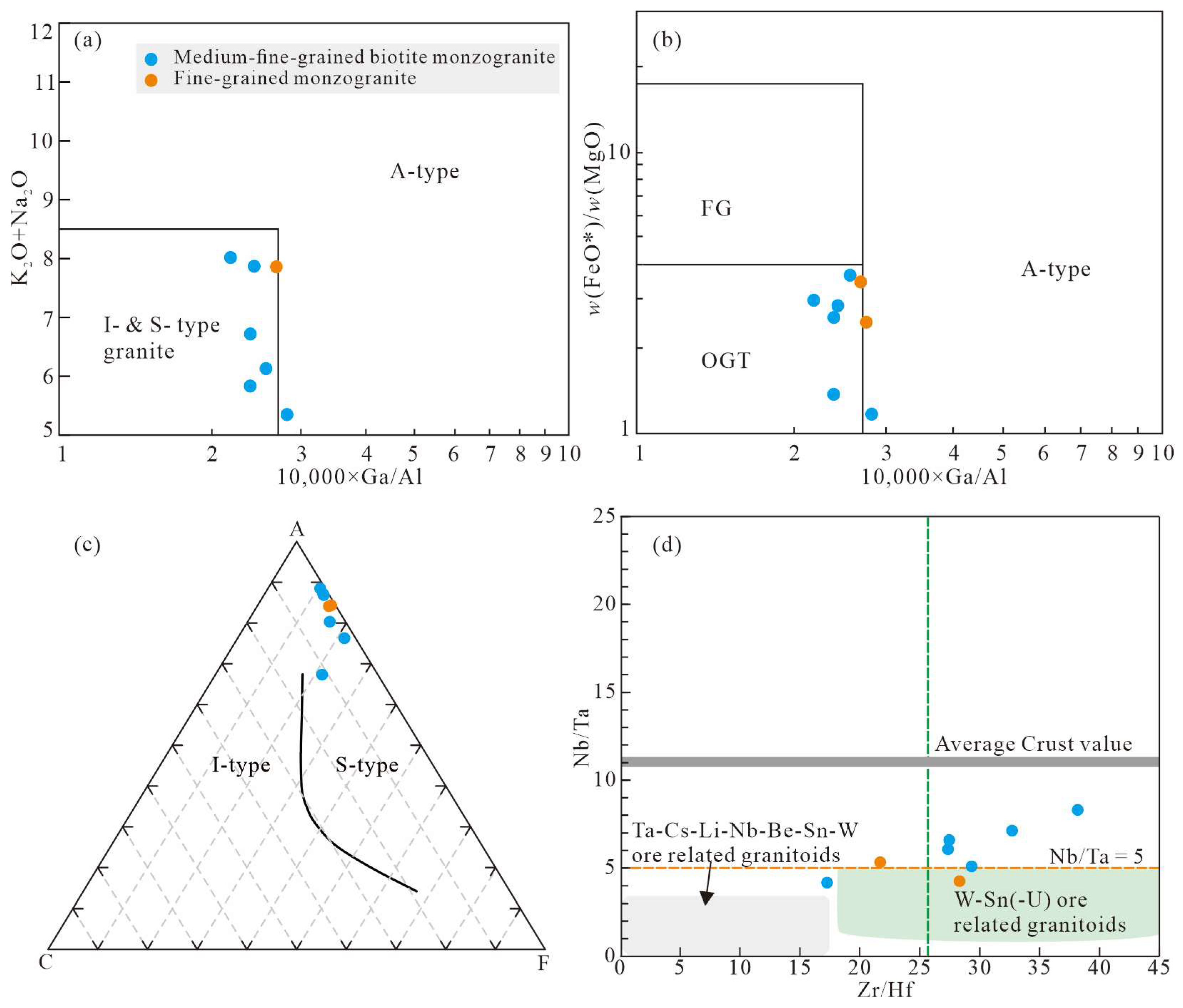
5.3. Tectonic Setting
6. Conclusions
- (1)
- The medium–fine-grained biotite monzogranite and the fine-grained monzogranite in the Mengshan granitoid complex mainly formed at 220.7 ± 1.0 Ma to 218.0 ± 0.8 Ma and 211.5 ± 2.9 Ma to 212.9 ± 1.0 Ma, respectively. They are the products of the magmatic evolution of the Mengshan complex up to a late stage. They belong to the category of S-type granites and are characterized by strongly peraluminous, high K calc-alkaline content, high silica content, high Cs and U concentrations, and low Th/U ratios. They were derived from the partial melting of Proterozoic continent basement rocks, and minor mantle materials were involved during their generation.
- (2)
- Combined with the systematic field investigation in this study and previous data, three stages of magmatism are proposed for the formation of the Mengshan granitoid complex, comprising medium–coarse-grained porphyritic biotite granite formed at ca. 236–223 Ma, medium–fine-grained biotite monzogranite formed at ca. 222–217 Ma, and fine-grained monzogranite formed at ca. 212–211 Ma.
- (3)
- The presence of the Early Mesozoic Mengshan granitoid complex reflects a reduplicated far-field converge effect of the collision of the North China and South China blocks and the subduction of the Palaeo-Pacific plate into the South China block. The thickening of the Earth’s crust facilitated crustal delamination, the underplating of mantle-derived magma, and crustal heating, triggering the intense partial melting of the lithosphere and magma enrichment.
Supplementary Materials
Author Contributions
Funding
Data Availability Statement
Acknowledgments
Conflicts of Interest
References
- Whalen, J.B.; Currie, K.L.; Chappell, B.W. A-type granites: Geochemical characteristics, discrimination and petrogenesis. Contrib. Mineral. Petrol. 1987, 95, 407–419. [Google Scholar] [CrossRef]
- Chappell, B.W. Aluminium saturation in I-and S-type granites and the characterization of fractionated haplogranites. Lithos 1999, 46, 535–551. [Google Scholar] [CrossRef]
- Ballouard, C.; Poujol, M.; Boulvais, P.; Branquet, Y.; Tartèse, R.; Vigneresse, J.L. Nb-Ta fractionation in peraluminous granites: A marker of the magmatic-hydrothermal transition. Geology 2016, 44, 231–234. [Google Scholar] [CrossRef]
- Moghadam, H.S.; Hoernle, K.A.; Hauff, K.A.; Hauff, F.; Chiaradia, M.; Schönberg, D.G.; Esquivel, T.O.; Bindeman, I.N.; Karsli, O.; Ghorbani, G.; et al. Middle-Late Miocene to Pleistocene Post-Collisional Magmatism in the Arabia-Eurasia Collision Zone, an Example from Northwest Iran. J. Petrol. 2023, 64, 081. [Google Scholar] [CrossRef]
- Förster, H.J.; Tischendorf, G.; Trumbull, R.B.; Gottesmann, B. Late-collisional granites in the Variscan Erzgebirge, Germany. J. Petrol. 1999, 40, 1613–1645. [Google Scholar] [CrossRef]
- Li, Z.X.; Li, X.H. Formation of the 1300km wide intracontinental orogen and postorogenic magmatic province in Mesozoic South China: A flat-slab subduction model. Geology 2007, 35, 179–182. [Google Scholar] [CrossRef]
- Zheng, Y.F.; Chen, R.X.; Xu, Z.; Zhang, S.B. The transport of water in subduction zones. Sci. China Earth Sci. 2016, 59, 651–682. [Google Scholar] [CrossRef]
- Rong, W.; Zhang, S.B.; Zheng, Y.F. Back-reaction of Peritectic Garnet as an Explanation for the Origin of Mafic Enclaves in S-type Granite from the Jiuling Batholith in South China. J. Petrol. 2017, 58, 569–598. [Google Scholar] [CrossRef]
- Li, X.H.; Liu, D.Y.; Sun, M.; Li, W.X.; Liang, X.R.; Liu, Y. Precise Sm-Nd and U-Pb isotopic dating of the supergiant Shizhuyuan polymetallic deposit and its host granite, SE China. Geol. Mag. 2004, 141, 225–231. [Google Scholar] [CrossRef]
- Li, X.H.; Li, Z.X.; Li, W.X.; Liu, Y.; Yuan, C.; Wei, G.J.; Qi, C.S. U–Pb zircon, geochemical and Sr–Nd–Hf isotopic constraints on age and origin of Jurassic I-and A-type granites from central Guangdong, SE China: A major igneous event in response to foundering of a subducted flat-slab? Lithos 2007, 96, 186–204. [Google Scholar] [CrossRef]
- Brown, M. Granite: From genesis to emplacement. Geol. Soc. Am. Bull. 2013, 125, 1079–1113. [Google Scholar] [CrossRef]
- He, X.L.; Yu, Q.Y.; Liu, S.Y.; Yang, M.J.; Zhang, D. Origin of the Erdaohe Ag–Pb–Zn deposit, central Great Xing’an Range, northeast China: Constraints from fluid inclusions, zircon U-Pb geochronology, and stable isotopes. Ore Geol. Rev. 2021, 107, 10439. [Google Scholar] [CrossRef]
- He, X.L.; Zhang, D.; Di, Y.J.; Wu, G.G. Evolution of the magmatic–hydrothermal system and formation of the giant Zhuxi W-Cu deposit in South China. Geosci. Front. 2022, 13, 101–278. [Google Scholar] [CrossRef]
- Vatuva, A.; He, X.L.; Zhang, X.M.; Zhang, D.; Feng, H.B.; Yuan, Y.; Wang, S.; Yi, J.J.; Di, Y.J. Genesis of Makeng-type Fe-polymetallic deposits in SE China: New constraints by geochronological and isotopic data from the Dapai–Makeng metallogenic system. Geosci. Front. 2023, 14, 101614. [Google Scholar] [CrossRef]
- Wan, L.; Jin, W.; Kusky, T.; Tian, Y.; Wang, J.; Ke, X.Z.; Long, W.G.; Yang, J.; Sun, X.M.; Chen, C. Late Jurassic granitoids in Mufushan complex and their significance for the Mesozoic tectonic evolution of eastern South China. Lithos 2024, 482–483, 107707. [Google Scholar] [CrossRef]
- Sajona, F.G.; Maury, R.C.; Pubellier, M.; Leterrier, J.; Bellon, H.; Cotten, J. Magmatic source enrichment by slab-derived melts in a young post-collision setting, Central Mindanao (Philippines). Lithos 2000, 54, 173–206. [Google Scholar] [CrossRef]
- Xiao, W.J.; Windley, B.; Sun, S.; Li, J.L.; Huang, B.C.; Han, C.M.; Yuan, C.; Sun, M.; Chen, H.L. A Tale of Amalgamation of Three Permo-Triassic Collage Systems in Central Asia: Oroclines, Sutures, and Terminal Accretion. Annu. Rev. Earth Planet. Sci. 2015, 43, 477–507. [Google Scholar] [CrossRef]
- McGee, L.E.; Smith, I.E. Interpreting chemical compositions of small scale basaltic systems: A review. J. Volcanol. Geotherm. Res. 2016, 325, 45–60. [Google Scholar] [CrossRef]
- Takach, M.K.; Bohrson, W.A.; Spera, F.J.; Viccaro, M. The Role of Crustal Contamination throughout the 1329–2005 CE Eruptive Record of Mt. Etna Volcano Italy. J. Petrol. 2024, 65, 028. [Google Scholar] [CrossRef]
- Cawood, P.A.; Buchan, C. Linking accretionary orogenesis with supercontinent assembly. Earth-Sci. Rev. 2007, 82, 217–256. [Google Scholar] [CrossRef]
- Maruyama, S.; Hasegawa, A.; Santosh, M.; Kogiso, T.; Omori, S.; Nakamura, K.; Kawai, K.; Zhao, D. The dynamics of big mantle wedge, magma factory, and metamorphic-metasomatic factory in subduction zones. Gondwana Res. 2009, 16, 414–430. [Google Scholar] [CrossRef]
- Wakita, K.; Pubellier, M.; Windley, B. Tectonic processes, from rifting to collision via subduction, in SE Asia and the western Pacific: A key to understanding the architecture of the Central Asian Orogenic Belt. Lithosphere 2013, 5, 265–276. [Google Scholar] [CrossRef]
- Curry, A.; Caricchi, L.; Lipman, P.W. Magmatic Evolution of Zoned and Unzoned Ignimbrites: Evidence for a Complex Crustal Architecture Feeding four Rapid-sequence, Caldera-forming Eruptions in the San Juan Mountains. Colorado J. Petrol. 2021, 62, 006. [Google Scholar] [CrossRef]
- He, X.L.; Zhang, D.; Chen, G.H.; Di, Y.J. Genesis of Zhuxi Copper-Tungsten Deposit, Jiangxi Province: Insights from mineralogy and chronology. J. Jilin Univ. Earth Sci. Ed. 2018, 48, 1050–1070. [Google Scholar]
- He, X.L.; Zhang, D.; Wu, G.G.; Di, Y.J. Control of interaction between stress and fluid in tectonic transition background on metallogenesis of giant Zhuxi W-Cu deposit, South China. Miner. Depos. 2021, 40, 1135–1159. [Google Scholar]
- Wang, X.; Hu, Z.; Yu, X.; Chen, G.; Li, Y.; Zhan, T.; Chen, S.; Liu, S.; Cheng, X.; Yang, S. Geological Characteristics and Prospecting Significance of the Shizhushan Superlarge Wollastonite Deposit in Mengshan, West Jiangxi Province. Acta Geosci. Sin. 2019, 40, 259–264. [Google Scholar]
- Yang, Y.; Pan, X.; Hou, Z.; Deng, Y.; Ouyang, Y.; Meng, D.; Xie, T. Petrogenesis, Redox State, and Mineralization Potential of Triassic Granitoids in the Mengshan District, South China. Front. Earth Sci. 2021, 9, 657618. [Google Scholar] [CrossRef]
- Yang, G.Q.; Zhang, Y.Y.; Liu, K.; Zhou, Y.; Wang, S.X.; Huo, H.L. Geochemistry and Zircon U–Pb Geochronology of the Wugongshan Granites in the Northwestern Jiangxi Area, China: Implications for the Paleozoic Tectonic Development of South China. Minerals 2023, 13, 1427. [Google Scholar] [CrossRef]
- Zhang, Y.Y.; Liu, K.; He, Q.C.; Hao, M.Y.; Guo, C.B.; Bai, J.J.; Yu, T.X. Zircon U-Pb ages, Hf isotopic characteristics, and geological significance of the Mesozoic granites in Wugong Mountains area, Jiangxi. Geol. Rev. 2022, 68, 1301–1319. [Google Scholar]
- Mu, J.; Zhao, S.; Brzozowski, M.; Li, H.; Wu, C.; Li, W. Geology, geochemistry and genesis of the world-class Shizhushan wollastonite deposit, Mengshan area, South China. Ore Geol. Rev. 2023, 158, 105469. [Google Scholar] [CrossRef]
- Zhong, Y.F.; Ma, C.Q.; She, Z.B.; Xu, H.J.; Wang, S.M.; Wang, L.X. U-Pb-Hf Isotope of Zircons, Geochemistry and Genesis of Mengshan Granitoids in Northwestern Jiangxi Province. Earth Sci.-J. China Univ. Geosci. 2011, 36, 703–720. [Google Scholar]
- Sun, J.D.; Li, H.L.; Lu, F.; Xu, M.C.; Wu, S.Z.; Zhang, Z.K. Geochemistry, Zircon U-Pb ages, and Hf isotopes of the Mengshan rock mass in Western Jiangxi Province and their geologic implication. Geol. Explor. 2022, 58, 96–106. [Google Scholar]
- Zhang, Y.Y.; Liu, K.; Tong, J.; He, Q.C.; He, X.L.; Jia, W.H.; Zhang, H.R.; Wang, S.X. Characteristics and Heat Source Mechanism of Geothermal Resources in Qianshan Area of Ji’an, Jiangxi Province. Acta Geosci. Sin. 2022, 1, 39–52. [Google Scholar]
- Hu, Z. The Formation Conditions and Matallogenic Regularity of Zhuxi Tungsten Polymentallic Deposit in Northeast of Jiangxi Province; Chengdu University of Technology: Chengdu, China, 2016. [Google Scholar]
- Wei, X.; Shi, G.H.; Zhang, X.C.; Zhang, J.J.; Shih, M. A New Nephrite Occurrence in Jiangxi Province, China: Its Characterization and Gemological Significance. Minerals 2024, 14, 432. [Google Scholar] [CrossRef]
- Liao, M. Geological Characteristics and Genesis of Non-Metallic and Polymetallic Deposits of Mengshan Region, Jiangxi Province. Adv. Geosci. 2012, 2, 211–216. [Google Scholar]
- Ye, Y.F.; Zhang, H.H. Study on Rock Petrogenesis and Tectomic Background of Mengshan Rock Mass in Western Jiangxi Province. Jiangxi Coal Sci. Technol. 2022, 1, 125–129. [Google Scholar]
- Faure, M.; Sun, Y.; Shu, L.S.; Monié, P.; Charvet, J. Extensional Tectonics within a Subduction-Type Orogen; The Case Study of the Wugongshan Dome (Jiangxi Province, Southeastern China). Tectonophysics 1996, 263, 77–106. [Google Scholar] [CrossRef]
- Faure, M.; Lepvrier, C.; Nguyen, V.V.; Vu, T.V.; Lin, W.; Chen, Z.C. The South China Block Indochina Collision: Where, When, and How. J. Asian Earth Sci. 2014, 79, 260–274. [Google Scholar] [CrossRef]
- Lou, F.S.; Shen, W.Z.; Wang, D.Z.; Shu, L.S.; Yu, J.H. Zircon U-Pb Isotopic Chronology of the Wugongshan Dome Compound Granite in Jiangxi Province. Acta Geol. Sin. 2005, 79, 636–644. [Google Scholar]
- Wang, D.Z.; Shu, L.S. Late Mesozoic basin and range tectonics and related magmatism in Southeast China. Geosci. Front. 2012, 3, 109–124. [Google Scholar] [CrossRef]
- Liu, X.Y.; Yang, X.H.; Nie, L.M.; Lei, T.H. Basic Characteristics of the Magma Core Complex at Wugongshan, Jiangxi. Acta Geol. Sin. 2016, 90, 468–474. [Google Scholar]
- Shu, L.S.; Wang, D.Z.; Shen, W.Z. Nd-Sr Isotopic Compositions of Granitic Rocks of the Mesozoic Metamorphic Core Complex in the Wugongshan Area, Jiangxi Province. J. Nanjing Univ. (Nat. Sci.) 2000, 36, 306–311. [Google Scholar]
- Hou, K.J.; Li, Y.H.; Tian, Y.R. In situ U-Pb zircon dating using laser ablation-multi ion counting-ICP-MS. Miner. Depos. 2009, 28, 481–492. [Google Scholar]
- Liu, Y.S.; Hu, Z.C.; Zong, K.Q.; Gao, C.G.; Gao, S.; Xu, J.; Chen, H.H. Reappraisement and refinement of zircon U-Pb isotope and trace element analyses by LA-ICP-MS. Chin. Sci. Bull. 2010, 55, 1535–1546. [Google Scholar] [CrossRef]
- Griffin, W.L.; Pearson, N.J.; Belousova, E.; Jackson, S.E.; Achterbergh, E.V.; O’Reilly, S.Y.; Shee, S.R. The Hf isotope composition of cratonic mantle: LAM-MC-ICPMS analysis of zircon megacrysts in kimberlites. Geochim. Cosmochim. Acta 2000, 64, 133–147. [Google Scholar] [CrossRef]
- Griffin, W.L.; Wang, X.; Jackson, S.E.; Pearson, N.J.; O’Reilly, S.Y.; Xu, X.S.; Zhou, X.M. Zircon chemistry and magma mixing, SE China: In situ analysis of Hf isotopes, Tonglu and Pingtan igneous complexes. Lithos 2002, 61, 237–269. [Google Scholar] [CrossRef]
- Middlemost, E.A.K. Naming materials in the magma/igneous rock system. Earth Sci. Rev. 1994, 37, 215–224. [Google Scholar] [CrossRef]
- Sun, S.S.; Mcdonough, W.F. Chemical and Isotopic Systematics of Ocean Basalts: Impications for Mantle Composition and Processes; Geological Society of London: London, UK; Blackwell Scientific Publications: London, UK, 1989; pp. 313–345. [Google Scholar]
- Rubatto, D.; Gebauer, D. Use of cathodoluminescence for U-Pb zircon dating by IOM Microprobe: Some examples form the western Alps. In Cathodoluminescence in Geoscience; Springer-Verlag: Berlin/Heidelberg, Germany, 2000; pp. 373–400. [Google Scholar]
- Cleasson, S.; Vetrin, V.; Bayanova, T.; Downes, H. U-Pb zircon ages from a Devonian carbonatite dyke, Kola peninsula, Russia: A record of geological evolution from the Archaean to the Palaeozoic. Lithos 2000, 51, 95–108. [Google Scholar] [CrossRef]
- Belousova, E.A.; Griffin, W.L.; O’Reilly, S.Y.; Fisher, N.I. Igneous zircon: Trace element composition as an indicator of source rock type. Contrib. Mineral. Petrol. 2002, 143, 602–622. [Google Scholar] [CrossRef]
- Griffin, W.L.; Belousova, E.A.; Shee, S.R. Crustal Evolution in the northern Yilarn Craton: U-Pb and Hf-isotope evidence from detrital zircons. Precambrian Res. 2004, 131, 213–282. [Google Scholar] [CrossRef]
- Wu, F.Y.; Li, X.H.; Zheng, Y.F.; Gao, S. Lu-Hf isotopic systematics and their applications in petrology. Acta Petrol. Sin. 2007, 23, 185–220. [Google Scholar]
- TGRGNP (The Granitoid Research Group of Nanling Project); Ministry of Geology and Mineral Resources. Geology of Granitoids of Nanling Region and Their Petrogenesis and Mineralization; Geological Publishing House: Beijing, China, 1989; pp. 18–66. [Google Scholar]
- Wang, Y.J.; Fan, W.M.; Sun, M.; Liang, X.Q.; Zhang, Y.H.; Peng, T.P. Geochronological geochemical and geothermal constraints on petrogenesis of the Indosinian peraluminous granites in the South China block: A case study in the Hunan Province. Lithos 2007, 96, 475–502. [Google Scholar] [CrossRef]
- Zhou, X.M.; Sun, T.; Shen, W.Z.; Shu, L.S. Petrogenesis of Mesozoic granitoids and volcanic rocks in South China: A response to tectonic evolution. Episodes 2006, 29, 26–33. [Google Scholar] [CrossRef] [PubMed]
- Wang, Y.J.; Fan, W.M.; Zhang, G.W.; Zhang, Y.H. Phanerozoic tectonics of the South China Block: Key observations and controversies. Gondwana Res. 2013, 23, 1273–1305. [Google Scholar] [CrossRef]
- Li, X.F. Spatial and temporal distributions and the geological setting of the W-Sn-Mo-Nb-Ta deposits at the northeast Guangxi, South China. Acta Geol. Sin. 2012, 86, 1713–1725. [Google Scholar]
- Mao, J.W.; Chen, Y.B.; Cheng, M.H.; Franco, P. Major types and time-space distribution of Mesozoic ore deposits in South China and their geodynamic settings. Miner. Depos. 2013, 48, 1019–1045. [Google Scholar]
- Feng, M.; Feng, Z.H.; Kang, Z.Q.; Fu, W.; Qing, Y.; Hu, R.G.; Cai, Y.F.; Feng, Y.Y.; Wang, C.Z. Establishing an Indosinian geochronological framework for episodic granitic emplacement and W-Sn-Nb-Ta mineralization in Limu mining district, South China. Ore Geol. Rev. 2019, 107, 1–13. [Google Scholar] [CrossRef]
- Chappell, B.W.; White, A.J.R. Two contrasting granite types. Pac. Geol. 1974, 8, 173–174. [Google Scholar]
- Chappell, B.W.; White, A.J.R. Two contrasting granite types: 25 years later. Aust. J. Earth Sci. 2001, 48, 489–499. [Google Scholar] [CrossRef]
- Deng, J.F.; Liu, C.; Di, Y.J.; Feng, Y.F.; Su, S.G.; Xiao, Q.H.; Zhao, G.C.; Dai, M.; Duan, P.X. Crustal convergent and accretional consumption zones, and continent-continent collisional orogenes and subduction aceretional orogenes: Records from the igneous petrotectonic assemblages. Earth Sci. Front. 2016, 23, 034–041. [Google Scholar]
- Sylvester, P.J. Post-collisional strongly peraluminous granites. Lithos 1998, 45, 29–44. [Google Scholar] [CrossRef]
- Wu, F.Y.; Li, X.H.; Yang, J.H.; Zheng, Y.F. Discussions on the petrogenesis of granites. Acla Petrol. Sin. 2007, 23, 1217–1238. [Google Scholar]
- Collins, W.J.; Beams, S.D.; White, A.J.R.; Chappell, B.W. Nature and origin of A-type granites with particular reference to southeastern Australia. Contrib. Miner. Petrol. 1982, 80, 189–200. [Google Scholar] [CrossRef]
- Pitcher, W.S. Granite type and tectonic environment. In Mountain Building Processes; Hsu, K., Ed.; Academic Press: London, UK, 1983; pp. 19–40. [Google Scholar]
- Huang, L.C.; Jiang, S.Y. Highly fractionated S-type granites from the giant Dahutang tungsten deposit in Jiangnan Orogen, Southeast China: Geochronology, petrogenesis and their relationship with W-mineralization. Lithos 2014, 202, 207–226. [Google Scholar] [CrossRef]
- Romer, R.L.; Kroner, U. Sediment and weathering control on the distribution of Paleozoic magmatic tin-tungsten mineralization. Miner. Depos. 2015, 50, 327–338. [Google Scholar] [CrossRef]
- Romer, R.L.; Kroner, U. Phanerozoic tin and tungsten mineralization-Tectonic controls on the distribution of enriched protoliths and heat sources for crustal melting. Gondwana Res. 2016, 31, 60–95. [Google Scholar] [CrossRef]
- Bea, F.; Montero, P. Behavior of accessory phases and redistribution of Zr, REE, Y, Th, and U during metamorphism and partial melting of metapelites in the lower crust: An example from the Kinzigite Formation of Ivrea-Verbano, NW Italy. Geochim. Cosmochim. Acta 1999, 63, 1133–1153. [Google Scholar] [CrossRef]
- Nakada, S.; Takahashi, M. Regional variationin chemistry of the Miocene intermediate to felsic magmas in the Outer Zone and the Setouchi Province of Southwest Japan. Geol. Soc. Jpn. 1979, 85, 571–582. [Google Scholar] [CrossRef]
- Pearce, J.A.; Cann, J.R. Tectonic setting of basic volcanic rocks determined using trace element analyses. Earth Planet. Sci. Lett. 1973, 19, 290–300. [Google Scholar] [CrossRef]
- Pearce, J.A.; Harris, N.B.W.; Tindle, A.G. Trace element discrimination diagrams for the tectonic interpretation of granitic rocks. J. Petrol. 1984, 25, 956–983. [Google Scholar] [CrossRef]
- Zhang, Y.Q.; Xu, X.B.; Jia, D.; Shu, L.S. Deformation Record of the Change from Indosinian Collision Related Tectonic System to Yanshanian Subduction-Related Tectonic System in South China during the Early Mesozoic. Earth Sci. Front. 2009, 16, 234–247. [Google Scholar]
- Zhang, Y.Q.; Dong, S.W.; Li, J.H.; Cui, J.J.; Shi, W.; Su, J.B.; Li, Y. The New Progress in the Study of Mesozoic Tectonics of South China. Acta Geosci. Sin. 2012, 33, 257–279. [Google Scholar]
- Ma, Q.L.; Yang, J.H.; Du, Y.S.; Dai, X.D.; Chai, R.; Guo, G.; Xu, Y.J. Early Triassic Initial Collision between the North China and South China Blocks in the Eastern Qinling Orogenic Belt. Tectonophysics 2021, 814, 228965. [Google Scholar] [CrossRef]
- Dong, Y.P.; Santosh, M. Tectonic Architecture and Multiple Orogeny of the Qinling Orogenic Belt, Central China. Gondwana Res. 2016, 29, 1–40. [Google Scholar] [CrossRef]
- Shi, W.; Dong, S.W.; Zhang, Y.Q.; Huang, S.Q. The Typical Large-Scale Superposed Folds in the Central South China: Implications for Mesozoic Intracontinental Deformation of the South China Block. Tectonophysics 2015, 664, 50–66. [Google Scholar] [CrossRef]
- Lin, W.; Faure, M.; Sun, Y.; Shu, L.S.; Wang, Q.C. Compression to Extension Switch during the Middle Triassic Orogeny of Eastern China; The Case Study of the Jiulingshan Massif in the Southern Foreland of the Dabieshan. J. Asian Earth Sci. 2001, 20, 31–43. [Google Scholar] [CrossRef]
- Shu, L.S. An Analysis of Principal Features of Tectonic Evolution in South China Block. Geol. Bull. China 2012, 31, 1035–1053. [Google Scholar]
- Wang, Y.J.; Wang, Y.; Zhang, Y.Z.; Qian, X. Indosinian Deformation in the South China Block and Interaction with the Adjoining Blocks. Geotecton. Metallog. 2022, 46, 399–415. [Google Scholar]
- Xia, Y.; Xu, X.H. The Epilogue of Paleo-Tethyan Tectonics in the South China Block: Insights from the Triassic Aluminous A-Type Granitic and Bimodal Magmatism. J. Asian Earth Sci. 2020, 190, 104129. [Google Scholar] [CrossRef]
- Faure, M.; Lin, W.; Schärer, U.; Shu, L.S.; Sun, Y.; Arnaud, N. Continental subduction and exhumation of UHP rocks: Structural and geochronological insights from the Dabieshan (East China). Lithos 2003, 70, 213–241. [Google Scholar] [CrossRef]
- Weislogel, A.L.; Graham, S.A.; Chang, E.Z.; Wooden, J.L.; Gehrels, G.E.; Yang, H.S. Detrital zircon provenance of the Late Triassic Songpan-Ganzi complex: Sedimentary record of collision of the North and South China blocks. Geology 2006, 34, 97–100. [Google Scholar] [CrossRef]
- Carter, A.; Clift, P.D. Was the Indosinian orogeny a Triassic mountain building or a thermotectonic reactivation event? C. R. Geosci. 2008, 340, 83–93. [Google Scholar] [CrossRef]
- Ferrari, O.M.; Hochard, C.; Stampfli, G.M. An alternative plate tectonic model for the Palaeozoic-Early Mesozoic Palaeotethyan evolution of Southeast Asia (northern Thailand-Burma). Tectonophysics 2008, 451, 346–365. [Google Scholar] [CrossRef]
- Blichert-Toft, J.; Chauvel, C.; Albarède, F. Separation of Hf and Lu for high-precision isotope analysis of rock samples by magnetic sector-multiple collector ICP-MS. Contrib. Mineral. Petrol. 1997, 127, 248–260. [Google Scholar] [CrossRef]
- Goolaerts, A.; Mattielli, N.; Jong, J.D.; Weis, D.; Scoates, J.S. Hf and Lu isotopic reference values for the zircon standard 91500 by MC-ICP-MS. Chem. Geol. 2004, 206, 1–9. [Google Scholar] [CrossRef]
- Soderlund, U.; Patchett, P.J.; Vervoort, J.D.; Isachsen, C.E. The 176Lu decay constant determined by Lu-Hf and U-Pb isotope systematic of Precambrian mafic intrusions. Earth Planet. Sci. Lett. 2004, 219, 311–324. [Google Scholar] [CrossRef]

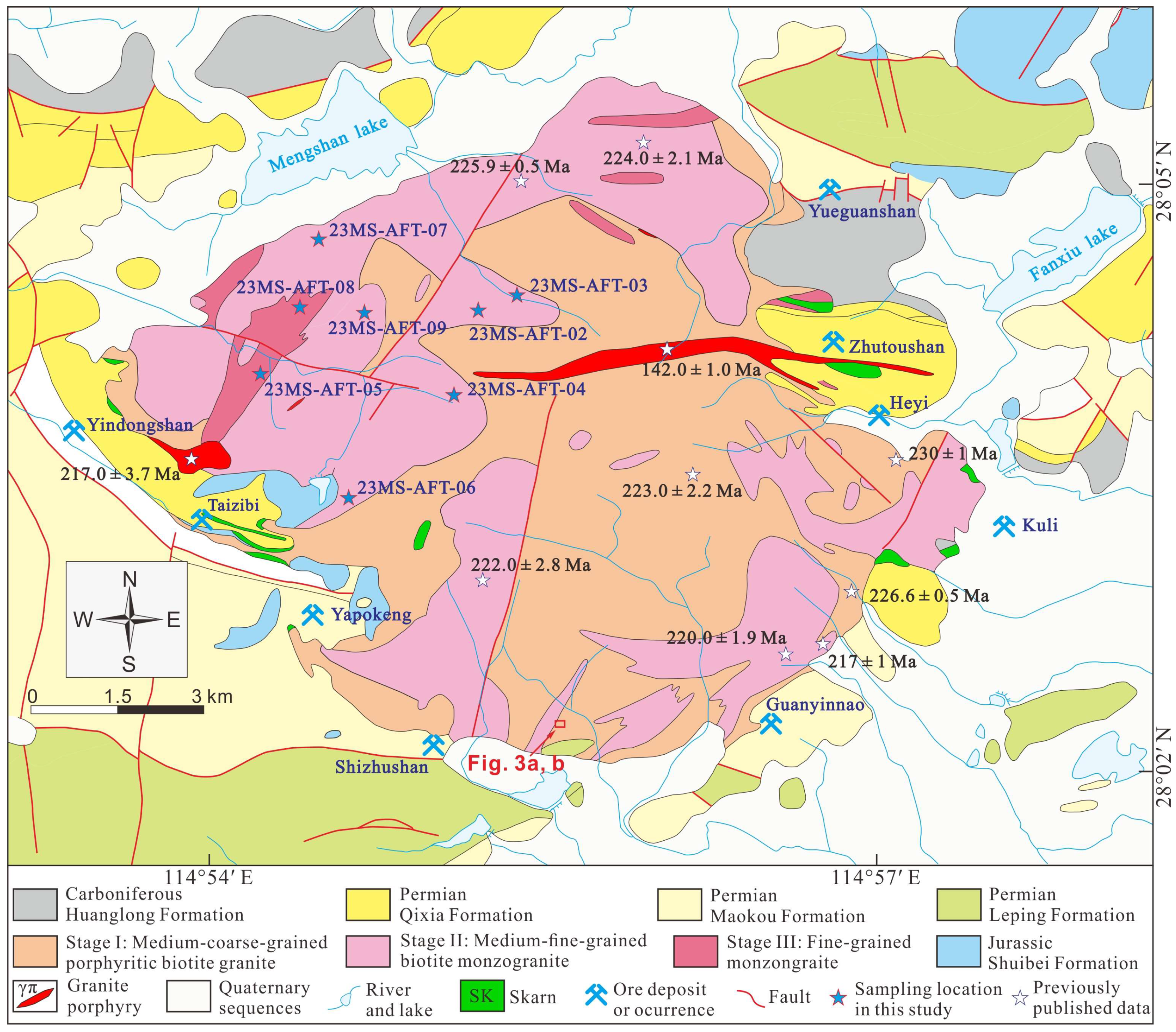
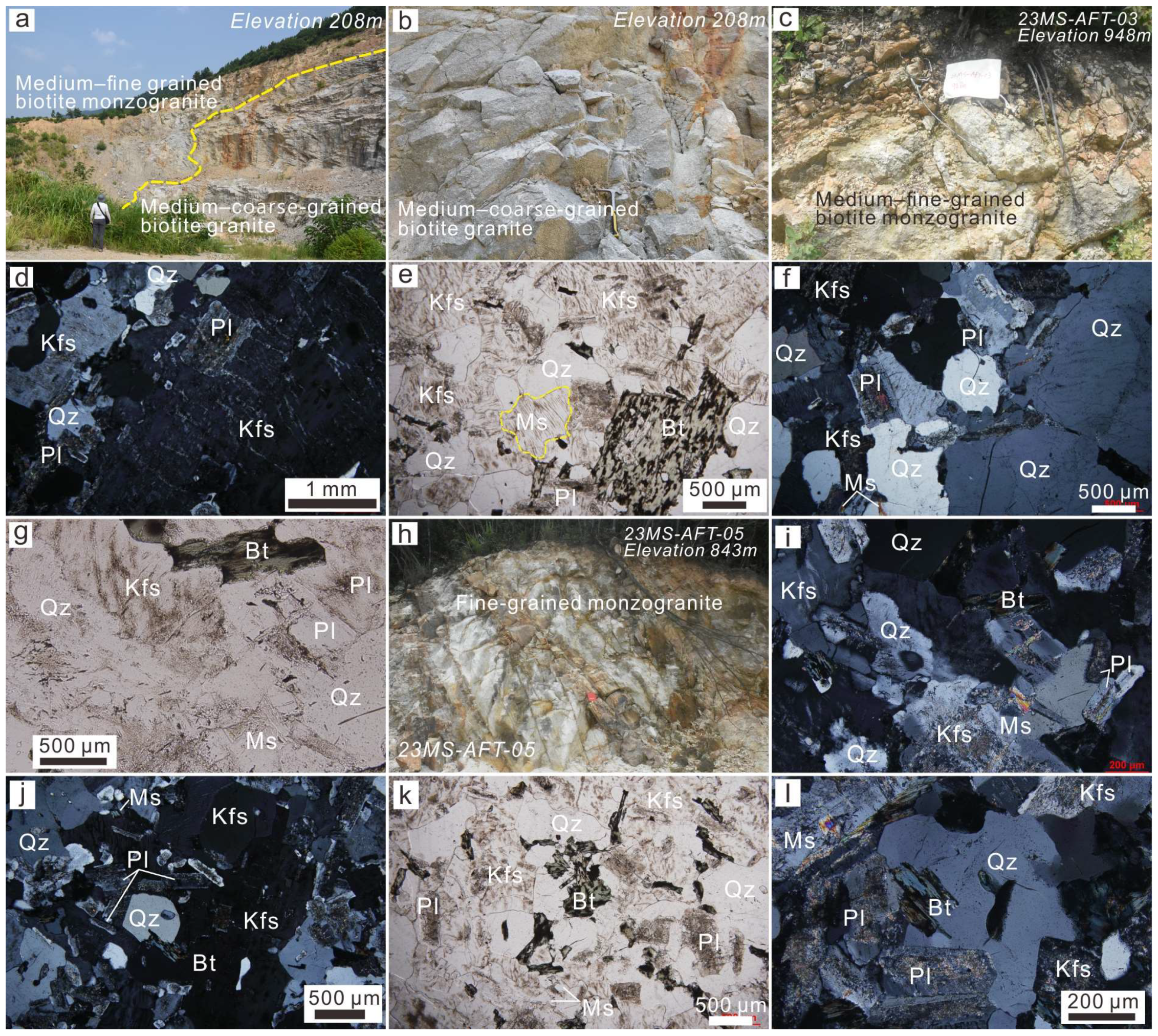
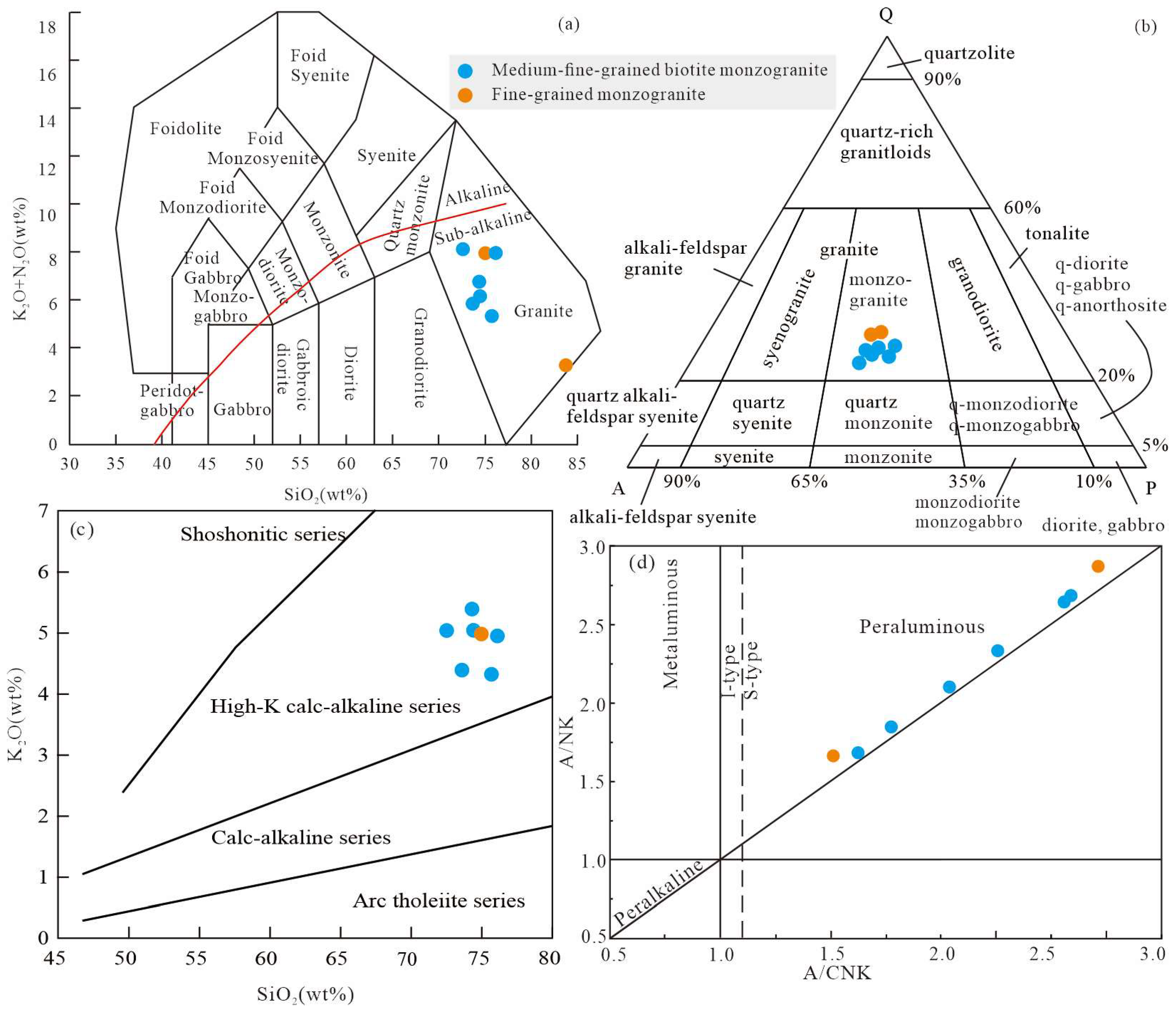
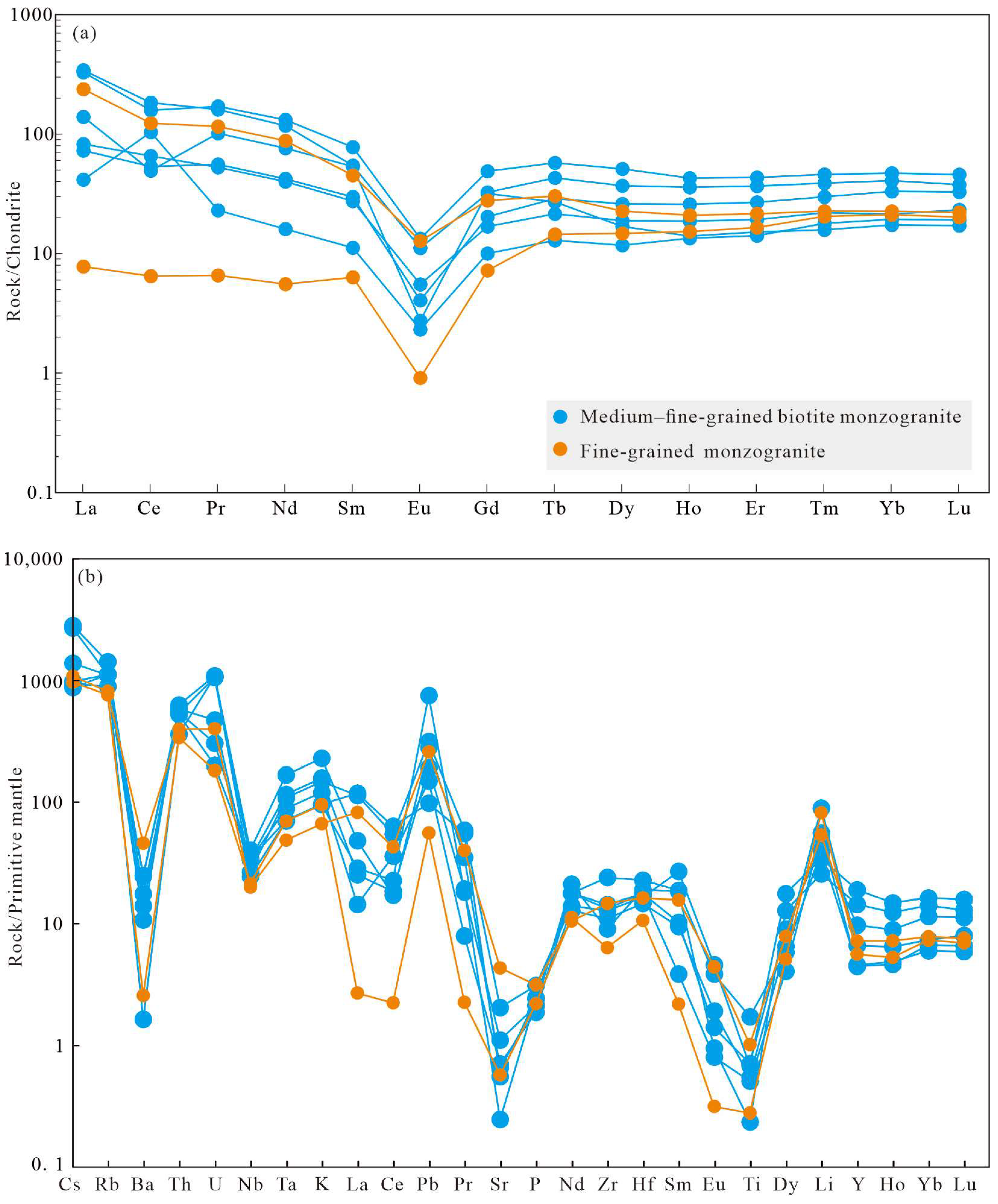


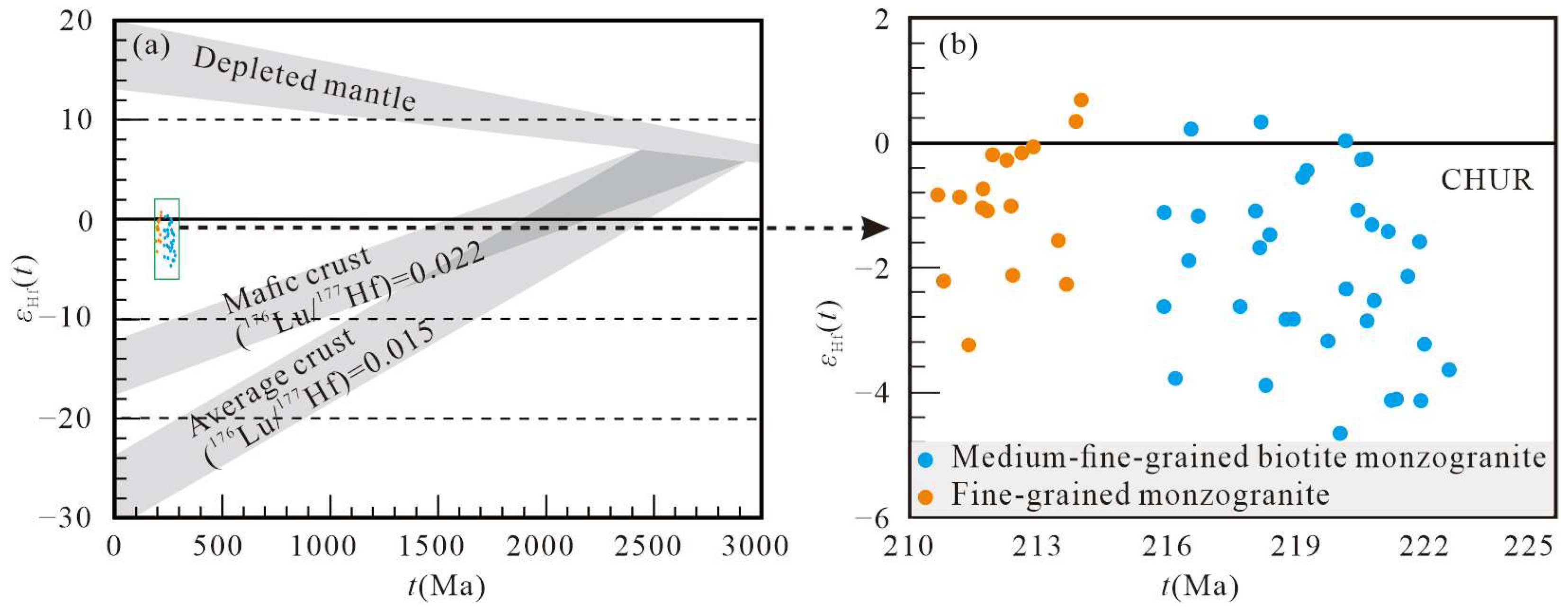

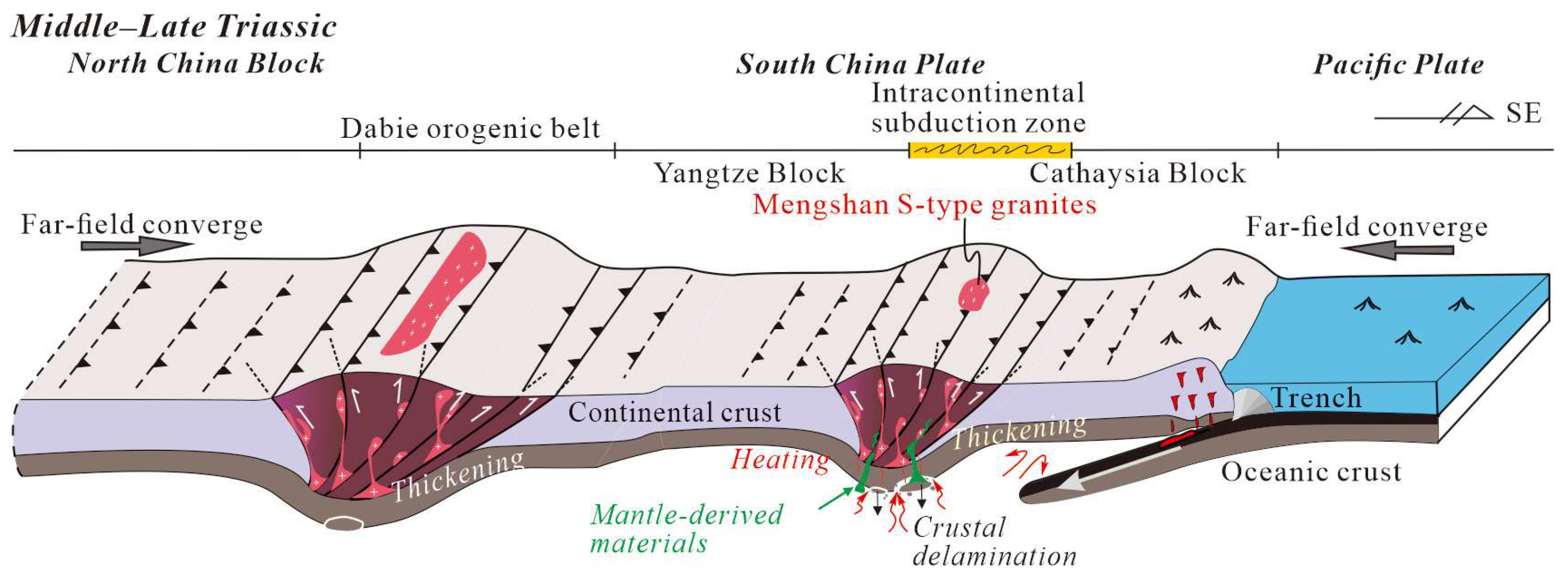
Disclaimer/Publisher’s Note: The statements, opinions and data contained in all publications are solely those of the individual author(s) and contributor(s) and not of MDPI and/or the editor(s). MDPI and/or the editor(s) disclaim responsibility for any injury to people or property resulting from any ideas, methods, instructions or products referred to in the content. |
© 2024 by the authors. Licensee MDPI, Basel, Switzerland. This article is an open access article distributed under the terms and conditions of the Creative Commons Attribution (CC BY) license (https://creativecommons.org/licenses/by/4.0/).
Share and Cite
Wei, J.; Ouyang, Y.; Zou, J.; Zeng, R.; Zhang, X.; Zhang, T.; Sui, S.; Zhang, D.; He, X.; Zhang, Y. Genesis of the Mengshan Granitoid Complex in an Early Mesozoic Intracontinental Subduction Tectonic Setting in South China: Evidence from Zircon U-Pb-Hf Isotopes and Geochemical Composition. Minerals 2024, 14, 854. https://doi.org/10.3390/min14090854
Wei J, Ouyang Y, Zou J, Zeng R, Zhang X, Zhang T, Sui S, Zhang D, He X, Zhang Y. Genesis of the Mengshan Granitoid Complex in an Early Mesozoic Intracontinental Subduction Tectonic Setting in South China: Evidence from Zircon U-Pb-Hf Isotopes and Geochemical Composition. Minerals. 2024; 14(9):854. https://doi.org/10.3390/min14090854
Chicago/Turabian StyleWei, Jin, Yongpeng Ouyang, Jing Zou, Runling Zeng, Xinming Zhang, Tao Zhang, Shenao Sui, Da Zhang, Xiaolong He, and Yaoyao Zhang. 2024. "Genesis of the Mengshan Granitoid Complex in an Early Mesozoic Intracontinental Subduction Tectonic Setting in South China: Evidence from Zircon U-Pb-Hf Isotopes and Geochemical Composition" Minerals 14, no. 9: 854. https://doi.org/10.3390/min14090854





